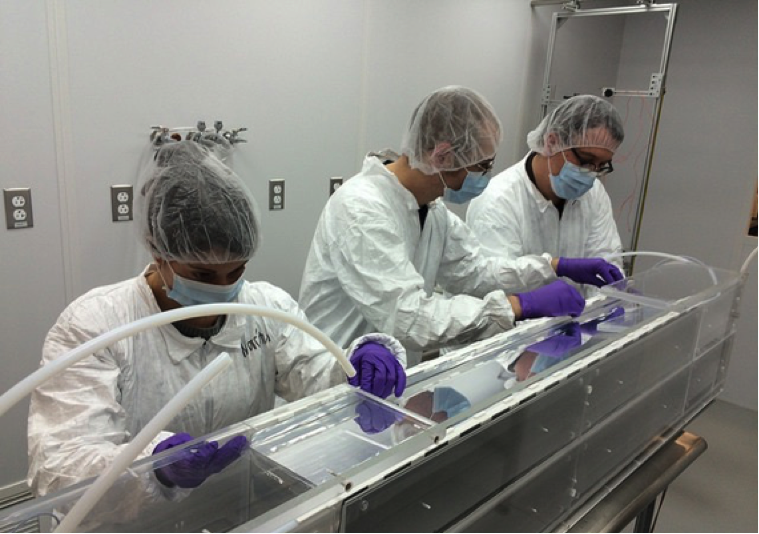
Illinois Tech physics researchers are part of the Precision Oscillation and Spectrum Experiment (PROSPECT) awarded $3 million by the U.S. Department of Energy to search for sterile neutrinos.
The Illinois Tech PROSPECT team includes Christopher White, vice provost for academic affairs and research and professor of physics; Bryce Littlejohn, assistant professor of physics; postdoctoral researchers Karin Gilje and David Martinez; and graduate students Pranava Surukuchi and Xianyi Zhang.
Some scientists have hypothesized that sterile neutrinos, even-more-mysterious cousins of the ghostly neutrino, may exist, but so far have no definitive proof. Another experiment, IceCube in the Antarctic, recently announced that it has not been able to find sterile neutrinos in two years of searching.
PROSPECT will use the $3 million award to construct a detector that can be used very close to the core of a nuclear reactor to try to catch a hint of the elusive particles. This first of its kind short-distance detection device will be used at the High Flux Isotope Reactor at Oak Ridge National Laboratory, in Tennessee.
White and Littlejohn also work on the Daya Bay reactor neutrino experiment, which has confirmed that neutrinos oscillate and also have mass. The Daya Bay data also suggest that there may be some other neutrino beyond the three already known. “At Daya Bay, we measured neutrino oscillations by watching neutrinos disappear as they traveled between our different detectors. We also were surprised that many neutrinos were already missing even before they reached our detectors,” noted Littlejohn. Creating an apparatus that will work closer to the reactor core may allow the PROSPECT team to precisely probe this new behavior, which could be the first smoking-gun signature of sterile neutrinos.
“By going very close to a research reactor — less than 10m from the reactor core — PROSPECT will have unparalleled sensitivity to study the energy distribution of neutrinos as they leave the reactor,” said Karsten Heeger, a Yale physicist and principal investigator for PROSPECT.
The Illinois Tech team will create a clean room in the basement of the Life Sciences building and manufacture and assemble a baseball-bat-length, honeycomb-like labyrinth of thin mirrors that will separate the PROSPECT detector into dozens of tube-like cells. When a neutrino interacts with the detector, flashes of light are produced in the nearby tubes. The Illinois Tech-produced reflecting walls then direct this flash to light sensors on each end of each tube.
The mirror components will be shipped to Yale after fabrication, where scientists and graduate students from Illinois Tech and other universities will assemble the experiment, which will then be moved to Oak Ridge.
“The sub-system we’re building will allow us to pinpoint exactly where each neutrino has interacted inside PROSPECT, information that is vital to achieving PROSPECT’s physics goals,” Littlejohn noted. The Illinois Tech group will also lead the analysis team probing Daya Bay’s “missing neutrino” problem with PROSPECT data.
A great deal of scientific research is currently focused on neutrinos, which are subatomic particles that move through the universe with almost no mass and no electrical charge. Incredibly difficult to detect, neutrinos’ properties and behavior may hold answers to fundamental questions about the nature of matter in the universe.
When neutrinos oscillate, they are able to change their type, or “flavor.” The discovery of this process, in 1998, was recognized with the 2015 Nobel Prize in physics and the 2016 Breakthrough Prize. By studying oscillations, scientists can probe the existence of matter beyond the parameters of the Standard Model of Particle Physics.
“Because of the natural radioactivity present at the Earth’s surface, detecting these elusive particles near an operating nuclear reactor is a very challenging task,” said Littlejohn. “However, the neutrino physics opportunities this measurement would open up make it well worth the effort. By applying new technologies and techniques in PROSPECT, we will make the first-ever precision neutrino measurements in this environment.” In addition, he pointed out, the technology could potentially improve the way we monitor and safeguard nuclear reactors, because neutrinos could be used to remotely detect illicit removal of nuclear materials from a reactor.
In all, the PROSPECT collaboration includes 68 scientists and engineers from 10 universities and four national laboratories. The collaborators include Brookhaven National Laboratory, Drexel University, Georgia Institute of Technology, Illinois Institute of Technology, Le Moyne College, the University of Tennessee-Knoxville, Temple University, the University of Waterloo, the College of William and Mary, University of Wisconsin-Madison, and Yale University.
